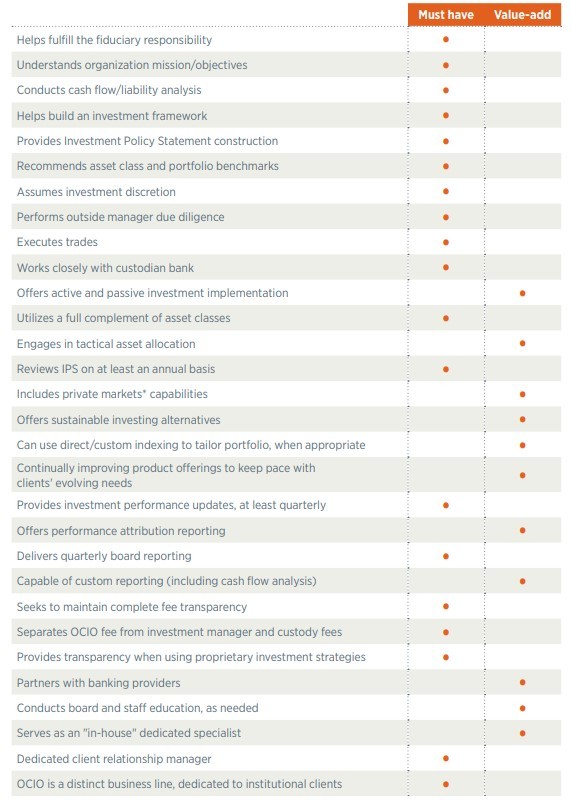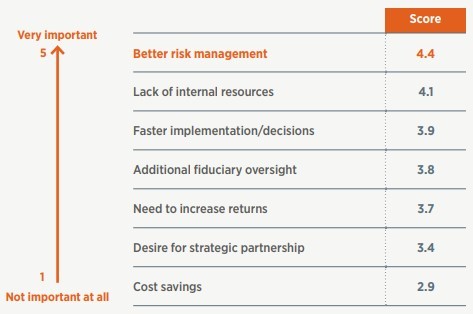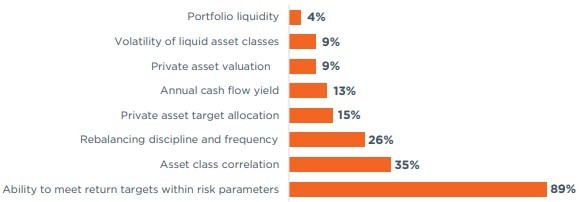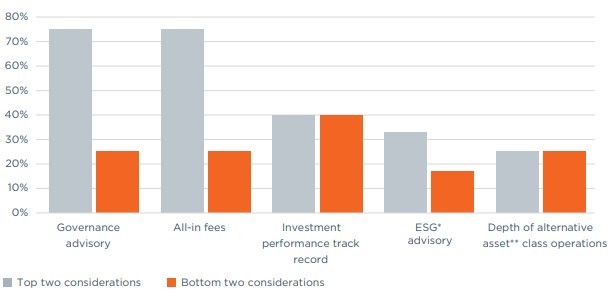 Equal Housing Lender. Bank NMLS #381076. Member FDIC.
Equal Housing Lender. Bank NMLS #381076. Member FDIC.
 Equal Housing Lender. Bank NMLS #381076. Member FDIC.
Equal Housing Lender. Bank NMLS #381076. Member FDIC.
Institutional investors of all types and sizes have most likely heard the term “outsourced chief investment officer,” or OCIO. It essentially refers to firms that are hired by institutions to take on investment management responsibility on behalf of that organization. For decades, institutions with pools of capital—such as endowments, foundations, pensions, defined contribution plans, insurance funds, and even corporate business entities—have engaged investment firms to either assist or fully manage their pools of capital.
As its name suggests, an OCIO is hired to replicate the duties of an internal chief investment officer and investment office staff. In many cases, particularly for institutions with less than $1 billion assets under management, an OCIO may be the only investment management resource for an organization. For this reason, we believe that vetting and hiring an OCIO is just as critical for small and mid-size institutions as building out an investment office is for their larger counterparts. Realistically, however, it is no mean feat for these leaner, more capacity or investment expertise-constrained organizations to sift through myriad candidates to find a qualified, skilled, and trustworthy OCIO partner.
In our view, the proliferation of institutions seeking these services and investment firms willing to grow their business has led to a wide disparity in the types of services that are provided and a lack of clarity on the value an OCIO can provide. Let’s take a closer look.
First and foremost, he meets with clients to understand their needs, goals, and constraints. Then, he helps construct a vision, builds a plan, and oversees the execution of both. This will require knowledge in “local building codes and safety regulations,” so to speak, to ensure they comply with local laws—as well as broad knowledge of related providers in order to hire the best contractors and subcontractors for your specific job. This typically places the architect in a better position than their clients to negotiate lower fees from contractors and suppliers. Furthermore, they should have the ability to oversee the project through to completion, course correcting for unforeseen issues and delivering the result that was discussed during the planning stages.
Unfortunately, our experience has shown us that many institutions engaged investment advisors thinking they paid for an architect, only to later learn they actually hired a contractor at architect fees. This can leave the institution’s leadership frustrated, exposed to fiduciary risk, and in the position of having to take on more work than they expected or are capable of completing. All of this can lead to suboptimal outcomes, such as underfunded pension plans, watered-down philanthropic programs, underfunded expansion projects, or other undesirable tradeoffs.
OCIO architects should work with decision makers and stakeholders to understand and, when appropriate, inform them about the vision and objectives of the institution. They should be capable of bringing a broad array of investment and reporting capabilities and possess deep experience in asset allocation, portfolio construction, and risk management. Additionally, they may also need to bring to the table comprehensive segment knowledge along with an understanding of the regulations that govern each specific entity. Lastly, they should provide dedicated client service and be able to work with additional vendors, such as banking partners, auditors, accountants, actuaries, and legal services. (See Figure 1, which provides a window into the broad spectrum of qualities and responsibilities that we believe translate into value for many institutional clients).
Figure 1: Our view on the characteristics of an OCIO that are required, as well as those that can add value

* Private markets are only available to investors that meet Securities and Exchange Commission standards and are qualified and accredited.
Source: Wilmington Trust Investment Advisors, Inc.
Institutions across the size and segment spectrum have been gravitating more toward using an OCIO model in recent years. According to Pensions & Investments, total worldwide outsourced assets are up 41.5% over the previous five years, ending March 31, 2023.2 In the United States, that trend is more pronounced with total outsourced assets up 52.4%. The publication also reports that the number of clients is up even more significantly, with endowments seeing a 164% increase, foundations up 133%, defined benefit plans up 82%, and defined contribution plans up a whopping 1,042%. This suggests the trend is moving down market.
The surge in OCIOs over the past few years begs the question: Why? What is the rationale for so many institutions outsourcing their investment responsibilities to a third party? The answers can be grouped into a few categories; improved risk management, better governance, cost savings, and investment sophistication, to name a few.
Figure 2: Reasons for outsourcing and their significance

Source: 2023 Outsourced Chief Investment Officer Survey, CIO Magazine, June 13, 2023.
Figure 3: Top portfolio concerns of institutional investors

Data as of 4Q 2021, published in 2022.
Source: Chestnut Advisory Group, “The Widespread Impact of OCIO Growth,” OCIO.org.
Understanding the framework within which your existing or prospective provider operates is crucial in helping to ensure expectations are aligned among the board, committees, staff, and providers hired to manage the investment portfolio. An alignment of convictions can lead to greater efficiencies, allowing an institution to focus on its mission while providers are dedicated to bringing that mission to life. Misalignment can lead to suboptimal outcomes at best, or a breach of fiduciary responsibility at worst. It is important to ask the following questions of—and receive satisfactory answers from—your provider or prospective provider:
The growth of institutional asset management and the desire to outsource critical investment management functions has led to a landscape that includes a wide variety of providers and services. We have observed that, in many cases, this has further led to a misalignment of expectations, overpaying for services, and increased fiduciary risk, often unbeknownst to the asset owner. All of this can result in suboptimal outcomes, causing harm to the mission of an institution, underfunded pension obligations, or financial shortfall for capital expenditures.
Knowledge is the first step in empowering you to fulfill your organization’s investment and other goals. To that end, clarifying whether your board or provider is truly fulfilling the many responsibilities of an OCIO can start the process of optimizing your investment strategy and uncovering resources that were previously unknown or underutilized. From there, go through the checklist of responsibilities to see where your organization—or OCIO—is lacking. To learn more, click here, and then reach out to us at OCIO@WilmingtonTrust.com to discuss next steps.
Figure 4: Most important factors driving OCIO hiring decisions

Data as of 4Q 2021, published in 2022.
Source: Chestnut Advisory Group,“The Widespread Impact of OCIO Growth,” OCIO.org.
* Environmental, social, and governance
**Alternative assets, such as strategies that invest in hedge funds, can present greater risk and are not suitable for all investors.
Please complete the form below and one of our advisors will reach out to you.
1 “Exposure Draft Guidance Statement for OCIO Strategies,” CFA Institute.
2 “Volatility, complex markets buoy OCIO,” Pensions & Investments, July 17, 2023.
This article is for educational purposes only and is not intended as an offer or solicitation for the sale of any financial product or service or as a determination that any investment strategy is suitable for a specific investor. Investors should seek financial advice regarding the suitability of any investment strategy based on their objectives, financial situations, and particular needs. This article is not designed or intended to provide financial, tax, legal, accounting, or other professional advice since such advice always requires consideration of individual circumstances. If professional advice is needed, the services of a professional advisor should be sought.
References to company names in this article are merely for explaining the market view and should not be construed as investment advice or investment recommendations of those companies.
References to specific securities are not intended and should not be relied upon as the basis for anyone to buy, sell, or hold any security. Holdings and sector allocations may not be representative of the portfolio manager’s current or future investments and are subject to change at any time.
The information in this article has been obtained from sources believed to be reliable, but its accuracy and completeness are not guaranteed. The opinions, estimates, and projections constitute the judgment of Wilmington Trust and are subject to change without notice. The investments or investment strategies discussed herein may not be suitable for every investor. There is no assurance that any investment strategy will be successful.
Third-party trademarks and brands are the property of their respective owners. Third parties referenced herein are independent companies and are not affiliated with M&T Bank or Wilmington Trust. Listing them does not suggest a recommendation or endorsement by Wilmington Trust.
Diversification does not ensure a profit or guarantee against a loss. Wilmington Trust is not authorized to and does not provide legal or tax advice. Our advice and recommendations provided to you is illustrative only and subject to the opinions and advice of your own attorney, tax advisor or other professional advisor.
There is no guarantee that integrating environmental, social, or governance (ESG) analysis will provide improved risk-adjusted returns over any specific time period. The evaluation of ESG factors will affect the strategy’s exposure to certain issuers, industries, sectors, regions, and countries and may impact the relative financial performance of the strategy depending on whether such investments are in or out of favor.
Stay Informed
Subscribe
Ideas, analysis, and perspectives to help you make your next move with confidence.
What can we help you with today